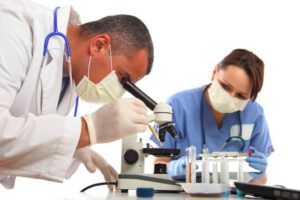 Amniocentesis and chorionic villus sampling (CVS) are among the most common tests for detecting genetic disorders. These tests’ main downside – they are invasive procedures that carry a risk for miscarriage (albeit a small risk) and are performed during the pregnancy when the fetus is already developing in the uterus.
Amniocentesis and chorionic villus sampling (CVS) are among the most common tests for detecting genetic disorders. These tests’ main downside – they are invasive procedures that carry a risk for miscarriage (albeit a small risk) and are performed during the pregnancy when the fetus is already developing in the uterus.
Many couples do not wish to terminate the pregnancy even in its early stages for ethical, religious, and personal reasons. These couples have no use in genetic testing performed after the onset of pregnancy, since these tests usually cannot lead to operative medical steps such as terminating the pregnancy and starting a new one.
What is PGD?
Pre-implantation genetic diagnosis (also known as PGD) is a method for diagnosing pre-embryos prior to implantation in the uterus, during an in vitro fertilization process (IVF).
In IVF, eggs are retrieved from a woman’s ovaries and fertilized by sperm in a laboratory. The fertilized eggs are grown for several days and then transferred to the uterus.
The pre-embryos are genetically tested at the laboratory. This testing process poses no risk for the embryos and allows testing for various genetic disorders.
How is the test performed?
During the testing of the pre-embryos, a single cell is sampled. Sampling a single cell out of the culture does not affect or harm the development of the future embryo. This single cell is used to isolate genetic material (that is found in all body cells) – which is then genetically tested. Only healthy pre-embryos, that are found to be free of genetic diseases, are transferred to the mother’s uterus.
The genetic tests performed on the pre-embryos include FISH testing and PCR testing.
A FISH test uses genetic sequencing to mark chromosome segments. This methos helps detect chromosome abnormalities that are associated with small-scale mutations.
In PCR testing, DNA segments are multiplied to identify specific genetic mutations.
These advanced methods help detect genetic diseases in pre-embryos before they are transferred to the uterus.
What diseases can PGD detect?
PGD can detect various genetic defects. This procedure is most used to diagnose severe autosomal recessive diseases, that are inherited from both parents when each parent is a carrier.
PGD is commonly used for an early diagnosis of cystic fibrosis (CF), thalassemia, sickle cell anemia, SMA disease, Huntington’s disease, fragile X syndrome, hemophilia, Duchenne muscular dystrophy, and more.
Since it can be used to detect known diseases, PGD is suitable for couples who are both found to be carriers of severe genetic disorders (whether through preconception genetic testing or following the birth of a child with a genetic disorder).
In these cases, PGD is the most suitable method for parents who want to ensure the birth of a healthy child but are not interested in pregnancy termination for various reasons.
PGD requires several cycles of IVF to achieve a healthy pregnancy.
Gender selection using PGD
In addition to testing for genetic diseases, PGD can easily be used to check the sex of the embryo. Sex is determined by the Y chromosomes. females have two x chromosomes while males have one x chromosome and one Y chromosome.
Choosing the sex of one’s child is theoretically and practically possible via IVF. This option raises an ethical debate – In the future, would it be possible for parents to choose other genetic traits of their child, besides sex?
Should parents be allowed to choose their baby’s sex? Some countries have imposed legal restrictions on this procedure.
While gender selection is legal in the US, it is illegal in most European countries.

